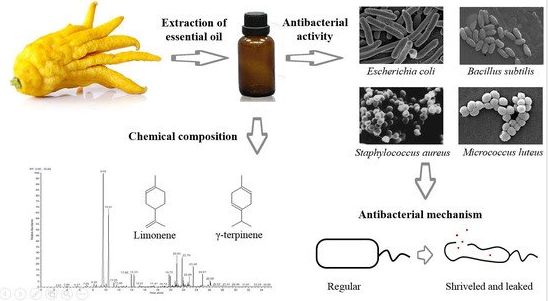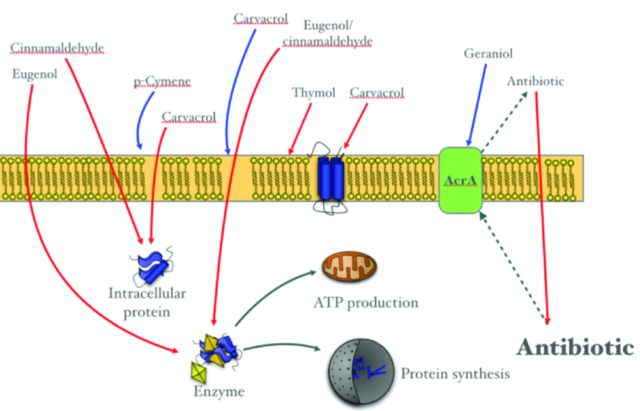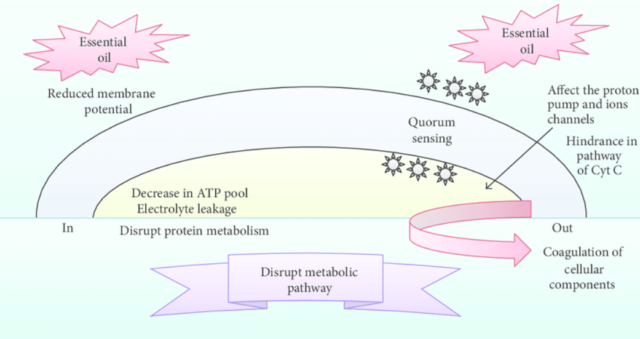R&D, Flavor & Fragrance Industry, Pharmaceutical
Analysis of Essential Oil on Antimicrobial Resistance

R&D, Flavor & Fragrance Industry, Pharmaceutical

Antimicrobial resistance (AMR) has become a growing challenge in the field of medicine. Essential oil (EO) is a potent and broad spectrum antibacterial agent with good bacteriostasis to bacteria, fungi, viruses and parasites.
Essential oil (EO) belong to a kind of volatile mixture containing rich natural bioactive compounds, like terpenes, phenols and alcohol, which are extracted from natural plants (flowers, leaves, stems, seeds, roots etc.) with low toxicity and excellent bacteriostatic action.
EO, Origanum vulgare Linn., Thymus mongolicus Ronn., Rosmarinus officinalis Linn. etc. have been widely used in food preservation. EO, tea tree oil, cinnamomum oil, peppermint oil, patchouli oil etc. play an important role in AMR with their good performance in bacteriostasis.

The main compounds, including sabinene, limonene, terpinen-4-ol, alpha-terpinene, gamma-terpinene, carvacrol, caryophyllene oxide etc, of EO not only show significant bactericidal action against gram-positive bacteria, but also weaken the resistance of MRSA to amoxicillin, tetracycline, piperacillin, ofloxacin and benzoxicillin.
Carvacrol & caryophyllene oxide existing in essential oil has antibacterial effect on gram-negative bacteria.
Cinnamomum oil and its trans-cinnamic aldehyde, benzyl alcohol nat and eugenol can reverse the resistance of Escherichia coli J53 R1 to piperacillin.
Tea tree oil, peppermint oil, thyme oil and clove oil have antibacterial effects against Candida albicans and foodborne strains including antibiotic-resistant isolates. The minimum inhibitory concentration (MIC) of terpinen-4-ol, main compound of tea tree oil, to Candida albicans is 0.06% ~ 0.5%. Terpinen-4-ol which could significantly enhance the sensitivity of fluconazole to Candida albicans has stronger anti-fungal effects than tea tree oil.
Zingiber officinale Rosc.Hyssopus officinalis L,sandalwood etc. have remarkable effects to kill herpes simplex virus type 1,HSV-1
EO mainly contains monoterpenes and sesquiterpenes which have effect of resisting rypanosoma brucei and could inhibit the egg and larva by interrupting their life cycle and/or preventing them from entering the infection stage.

Inhibition Mechanism of Essential Oil on Antimicrobial resistance
Terpinen-4-ol and geraniol could lead to changes in the fatty acid composition of Burkholderia cepacia’s cell membrane and damage of membrane structure. Carvonol & para cymene could break the membrane integrity of methicillin-resistant Staphylococcus aureus and Listeria monocytogenes by inhibiting their AMR.
Efflux Pumps can actively pump antimicrobial agents or other substrates from the bacterial cell. EO and its active compounds (monoterpenes and sesquiterpenes) can inhibit the drug efflux pump on cell membrane by reducing the resistance of Staphylococcus Aureus (MRSA) to Norfloxacin. For example, when alpha pinene is combined with Norfloxacin, MIC to MRSA is decreased by 64 times. when alpha pinene is combined with tetracycline, MIC is decreased by 4 times. Monoterpenes, like Terpinen-4-ol, alpha-/delta-terpineol have strong antibacterial effects and could kill Efflux dependent bacteria.
Biofilms make bacteria more resistant to antibiotics, host defense, and promote the persistence of bacteria in chronic infections through medical devices. Beta pinene has the ability to control drug-resistant enterococcus faecalis strains and reduce the number of biofilms attached to nonbiological surfaces. The antibiofilm activities of para-cymene, alpha-terpinene, gamma-terpinene etc. are significant for oral bacteria either alone or in combination with tetracycline. Citral, L-limonene, D-limonene can inhibit or eliminate the formation of MRSA biofilm, and can be used as food additives and environmental disinfectants.
After the combination of cinnamon oil and piperacillin, the bioluminescence expression of Escherichia coli and multi-drug resistant Escherichia coli decreased, indicating that cinnamon oil may be inhibitor of QS and has anti-QS effect.

| Active Materials | Function | Mechanism |
| Terpenes, Terpinen-4-ol, Para-cymene, Geraniol, Alpha-terpinene | Destroying the cell membrane & cell walls of bacteria.
Penetrating into the outer membrane of gram-negative bacteria & lipid layer of mitochondria |
Change the permeability of the outer membrane |
| Alpha Pinene, Terpinen-4-ol, Geraniol, | Inhibiting efflux pumps on bacterial membrane;
Decreasing the gene expression levels for PmrA, tet(K) |
Inhibition of Drug Efflux Pumps |
| Beta Pinene, Para Cymene, Gamma Terpinene, Menthol, Thymol, Terpinolene | Reducing the number of attached biofilms;
Inhibiting the formation of biofilms and extracellular polysaccharide synthesis (cellulose), flagellar formation; Reducing gene expression for fliD, flgJ, motA, motB associated with flagellar setting. |
Inhibition of biofilm formation
|
| Trans cinnamaldehyde | Inhibiting bacterial QS;
Decreasing gene expression of bcsA, luxR; Interfering QS self-inducers and the formation of biofilms |
Anti Quorum Sensing |
| Trans cinnamaldehyde | Targeting specificity on Z-ring spatial arrangement of bacterial and dissipating Z-ring through reducing Z-ring frequency.
Combining FtsZ area. |
Inhibition of becterial cell division
|
Applications of EO as alternative antibiotics
Studies have shown that patients with immune diseases may develop highly resistant pathogens after prolonged exposure to antibiotics. Introduction of EO is conductive to the treatment of local bacterial infections and the eradication of gram-positive and gram-negative bacteria.
In order to reduce or even eliminate microbial contamination in food and food contact surfaces, synthetic or natural compounds may be added directly to food or added to its packaging for cleaning and disinfection purposes.
Volatile compounds of EO with excellent pharmacological effects have long been regarded as good antibacterial agents and antioxidants for extending shelf-life of food and are widely used to resist multi-drug resistant pathogenic microorganisms.
Studies have shown that essential oil like cinnamon oil, oregano oil, thyme oil etc. and their main components (cinnamyl aldehyde, carvacrol, thymol) combined with conventional antibiotics (oxytetracycline, cotrimoxazole, gentamicin and penicillin) can reduce antimicrobial use and control streptococcus suis infection.